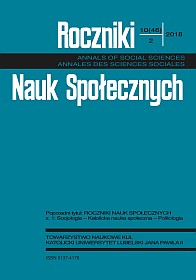Hatha-Yoga in Higher Education
Abstrakt
Hatha-yoga w szkolnictwie wyższym
Niniejszy artykuł porusza kwestię adaptacji praktyki hatha-yogi do systemu szkolnictwa wyższego. Autor opisuje problemy, jakie występują przy włączaniu jogi do programów nauczania uczelni wyższych w odniesieniu do USA i Polski.
Ciało zostało prawie wyłączone z programów nauczania. Istnieje jednak duża różnica między teorią a praktyką, a ciało może być aktywnym podmiotem (aktorem) w uczeniu się i postrzeganiu rzeczywistości. Może być używane do nauczania filozofii, psychologii, socjologii i zarządzania oraz innych kursów. Studenci mogą uzyskać ucieleśnioną wiedzę, a nie tylko możliwość zdobycia intelektualnej wiedzy pochodzącej z umysłu. Jestem socjologiem i opisuję swoje doświadczenia z włączaniem jogi w nauczanie przedmiotów socjologicznych i psychologicznych na polskim uniwersytecie. Wyniki autoraportów studentów pokazują, że poprzez praktykę hatha-jogi studenci mogli dostrzec związek ciała i umysłu w zakresie wytwarzania emocji, co może być ważne w nauczaniu technik redukcji stresu, socjologii emocji, psychologii emocji, filozofii ciała, zarządzania, coachingu lub innych przedmiotów, w których emocje i ciało są ważnymi czynnikami aktywności.
Bibliografia
Cohen, J.B. 2006. The missing body – Yoga and higher education. The Journal of the Assembly for Expanded Perspectives in Learning, 12 (winter), 14-24.
Conboy, L.A., Noggle, J.J., Frey, J.L., Kudesia, R.S., Khalsa, Sat Bir S. 2013. Qualitative evaluation of a high school yoga program: feasibility and perceived benefits. Explore. The Journal of Science and Healing, 9(3), 171-180.
Cooley, Ch. 1922. Human Nature and the Social Order. New York: Charles Scribner’s Sons.
Daut, C. 2016. A Case for More Yoga on Campus: Yoga as Self-Care for Higher Education and Student Affairs Professionals. The Vermont Connection, 37(6), 48-60.
Dewey, J. 1938. Experience & Education. New York, NY: Kappa Delta Pi.
Douglass, L. 2010. Yoga in the public schools: Diversity, democracy and the use of critical thinking in educational debates. Religion & Education, 37 (2), 162-169.
Douglass, L. 2011. Yoga in Higher Education: North American Educators and the Use of Yoga as Pedagogy, dissertation for the degree of Philosophy, Lesley University. (http://ir.flo.org)
Douglass, L. 2011a. Yoga as a counternarrative: American higher education rethinks difference and interdependency. Pedagogy, Pluralism and Practice, (15), 1-35.
Felver, J.C., Butzer, B., Olson, K.J., Smith, I.M., Khalsa, Sat Bir S. 2015. Yoga in public school improves adolescent mood and affect. Contemporary School Psychology, 19(3), 184-192.
Helberg, N., Heyes, C., and Rohel, J. 2009. Thinking through the body: Yoga Philosophy, and Physical Education. Teaching Philosophy, 32(3), 263-284.
Iyengar, B.K.S. 1983. Light on Pranayama. Pranayama Dipika. London: Unwin Paperbacks.
Iyengar, B.K.S. 2002. The Tree of Yoga. Boston: Shambhala.
Iyengar, B.K.S. 2005. The Illustrated Light on Yoga. New Delhi: HarperCollins Publishers India & The India Today Group.
Iyengar, B.K.S. 2005a. The Illustrated Light on Yoga. New Delhi: HarperCollins Publishers India & The India Today Group.
Iyengar, B.K.S. 2005b. Light on Life. The Yoga Journey to Wholeness, Inner Peace, and Ultimate Freedom. Pennsylvania: Rodale.
Khalsa, Sat Bir S. and Butzer, B. 2016. Yoga in school settings: a research review. Annals of the New York Academy of Sciences, 1373(1), 45-55.
Konecki, K.T. 2015. Is the Body the Temple of the Soul? Modern Yoga Practice as a Psychosocial Phenomenon. Kraków: Jagiellonian University Press.
Konecki, K.T. 2017. Stanting in Public Places: An Ethno-Zenic Experiment Aimed at Developing the Sociological Imagination and More Besides. Czech Sociological Review, 6, 881-901.
Leder, D. 1990. The Absent Body. Chicago: University of Chicago Press.
Morley, J. 2001. Inspiration and expiration: Yoga practice through Merleau-Ponty’s phenomenology of the body. Philosophy East and West, 51 (Jan), 1; ProQuest Central.
Orr, D. 2002. The uses of mindfulness in anti-oppressive pedagogies: philosophy and praxis. Canadian Journal of Education, 27(4), 477-497.
Pagis, M. 2010. From Abstract Concepts to Experiential Knowledge: Embodying Enlightenment in a Meditation Center. Qualitative Sociology, 33, 469-489.
Scheff, T. 1990. Microsociology. Discourse, Emotion, and Social Structure. Chicago: The University Press.
Scheff, T. 2014. Role-taking, Emotion and The Two Selves. Canadian Journal of Sociology/Cahiers Canadiens de Sociologie, 39 (3), 315-329.
Singleton, M. 2010. Yoga Body. The Origin of Modern Posture Practice. Oxford: Oxford University Press.
Singleton, M. 2010b. Translations, Belief Frameworks and Modern Yoga Practice. The Magazine of Yoga, http://themagazineofyoga.com/blog/2010/10/12/conversation-mark-singleton/ [September 04, 2011].
Singleton, M. 2010c. Yoga’s Greater Truth. Yoga Journal, http://www.yogajournal.com/wisdom/2610 [September 03, 2011].
Singleton, M. 2013. Transnational Exchange and the Genesis of Modern Postural Yoga. Pp. 37-56 in: Yoga Travelling. Bodily Practice in Transcultural Perspective, edited B. Hauser. Heidelberg, New York, Dordrecht, London: Springer.
Sjoman, N. 1996. The Yoga Tradition of the Mysore Palace. New Delhi: Abhinav Publications.
Copyright (c) 2018 Roczniki Nauk Społecznych

Utwór dostępny jest na licencji Creative Commons Uznanie autorstwa – Użycie niekomercyjne – Bez utworów zależnych 4.0 Międzynarodowe.


